My dad, Jose Turla Joson, lived at a time when there was no internet yet. But surprisingly, my Dad’s name, Jose Joson can be found on the internet! He is mentioned in relation to the history of Bayugan City, in the province of Agusan del Sur, Philippines. According to the internet, my dad led the early settlers in their desire to make Bayugan a barrio ( now called, barangay) during the 1960s.
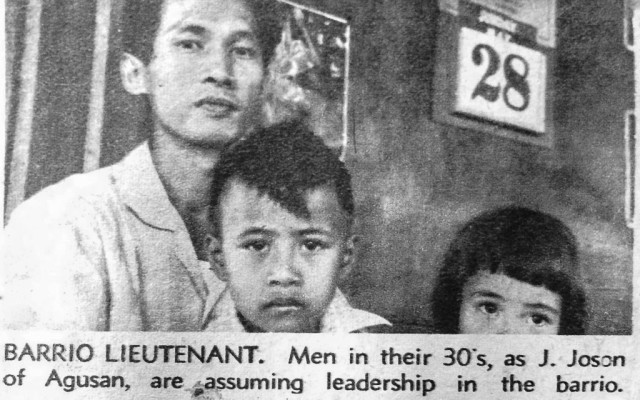
History of Bayugan City
Bayugan City used to be just a small settlement (a sitio). Back then, it was not even a barrio yet. In so far as I can remember, it was sitio Bayugan, part of Barrio Maygatasan, in the town of Esperanza, province of Agusan. It was located at the “crossing” of the Butuan-Davao road and the Valbueco-Esperanza road. As a young boy, we used to live right at the “crossing” when there was no rotunda yet. It was aptly called the “crossing” by the early settlers during the early 60s. We used to live right at the center (almost) of the present rotunda.
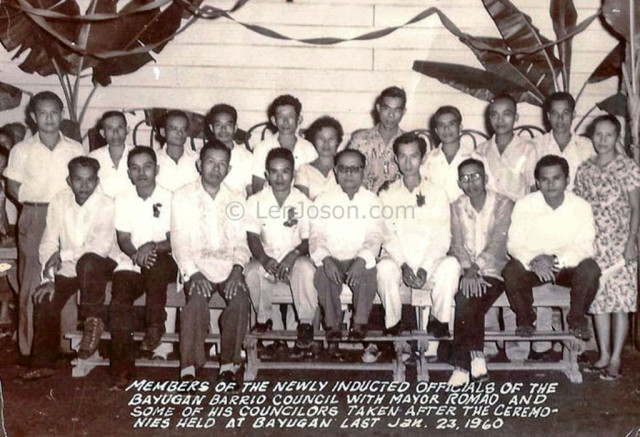
As Bayugan’s first Tiniente del Barrio, I remember my Dad settled a lot of disputes among the barrio folks. He also counseled on marital and family problems at times. That’s how I remembered it during those early days of Bayugan. I also remember that my Dad had one rural police under him. He had a khaki uniform but he had no shoes—just slippers! And he had no gun too but just a short batuta (club) haha!
Post-humous Award for First Barangay Captain
On April 2005, my Dad posthumously received a plaque of recognition for having served as “Barangay Captain” during the years 1960-1964. I find this humorous because back then, he was never called a captain. Just a lieutenant. No, not in the military. A barrio lieutenant! Or in Spanish, the first Tiniente del Barrio of Bayugan hahaha!
Off to US after Serving as Provincial Board Member
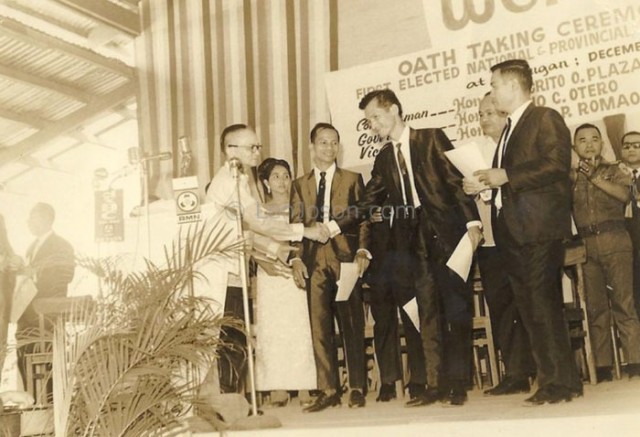
On December 31, 1969, the province of Agusan was divided into two. My Dad was among the first three elected provincial board members of the newly-formed province of Agusan del Sur. He served in the province until 1985. In 1985 my mom and dad went to Missouri. He was invited to attend a reunion in of his former American war buddies during World War II. My dad was the only Filipino in that group of American soldiers who fought in the Philippines against the Japanese troops.
Unfortunately, my Dad was never recognized officially by the Philippine government as a war veteran. According to my Dad, some Filipinos got their papers processed although they were fakes and became “veterans” after the war enjoying veteran’s benefits. He said he did not pursue being recognized as a veteran because all he wanted was to serve his country. I admire him for that.
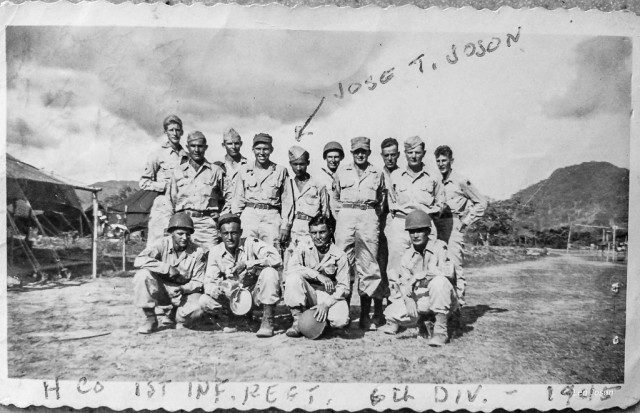
Recognized as WWII Veteran in US
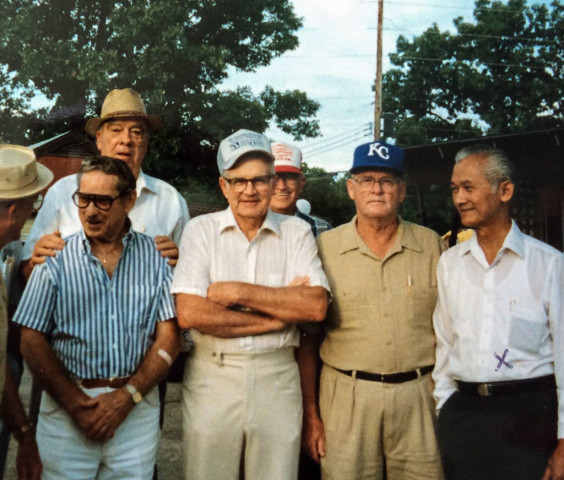
Thankfully, my Dad’s American war buddies did corroborate his being a real war veteran. Years later, my dad died of a heart attack in 1990 in Los Angeles, USA. He was buried in Oregon. After some 17 years, in August 2007, I had the chance to visit my Dad’s grave. Interestingly for me, I read on my Dad’s gravestone written in capital letters, “WWII VETERAN.”
I thought it was odd that my Dad was recognized as war veteran in a foreign land but not in our own country, the Philippines. Oh well. At least, he was recognized by his very own American war buddies during WWII—although not officially by the US government.
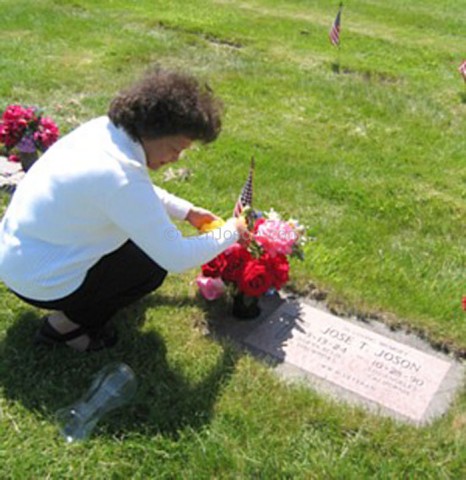
Finally, this part of Bayugan City history is now written and is on the internet. I’m writing this for my kids so that they may know more about their grandfather, my Dad. And may I share this for everyone too. From a very small settlement decades ago, Bayugan is now officially a city—Bayugan City! And my dad had some part in it.

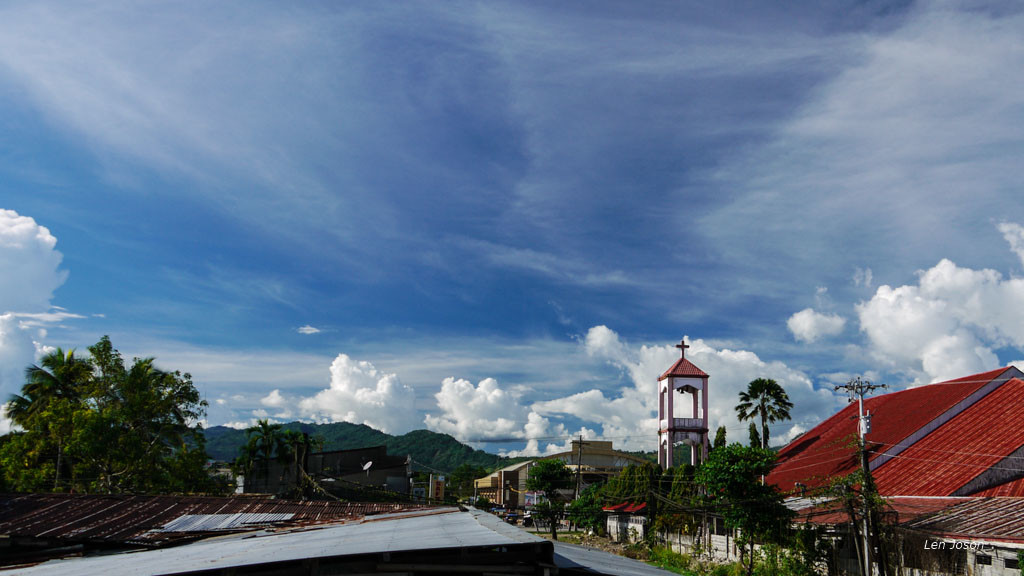
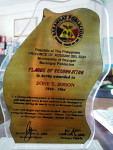
thank pastor ,
ang tanda ko na diko alam history ng bayugan. jan ako pinanganak sa sta.lrene bayugan at ng aral ako ng elwmentary sa west bayugan elementary school.hangang hi school sa SMA. nuong 1974,pero sa inyo kolang pala mlaman ang history ng bayugan.
napaka interesring info.GOD bless ../
No problem Beth. Peace be with you. God bless you and your masteral studies!
good evening mam len,
I’ve been reading your blog and the information you’ve written really help me in my subject today. Bayugan City will not exist without a founder like your dad and I admire him for his valuable contributions in the development of Bayugan City. And I would like to ask permission to reproduce a copy of the photos of our late Tiniente del Barrio here in your blog. It would be a great resource tool in writing the history of Bayugan.
I’m hoping for your positive response mam and thank you in advance.
Hello Beth,
No problem. Go ahead. Please don’t forget the photo credit. Thanks.
And oh by the way, I’m a “he” not a “she” haha!
Hello, Beth! You may want to read the following books which contain chapters dealing with pre-Hispanic Filipino culture: (a) Greg Hontiveros, BUTUAN OF A THOUSAND YEARS (Butuan City: Butuan City Historical and Cultural Foundation, Inc., 2004); (b) Martin J. Noone, THE ISLANDS SAW IT: THE DISCOVERY AND CONQUEST OF THE PHILIPPINES, 1521-1581 (Ireland: Helicon Press, 1982); (c) John Leddy Phelan, THE HISPANIZATION OF THE PHILIPPINES: SPANISH AIMS AND FILIPINO RESPONSES, 1565-1700 (Madison: The University of Wisconsin Press, 1959; reprinted 2010); (d) Peter Schreurs, MSC, CARAGUA ANTIGUA 1521-1910 (Cebu City: San Carlos Publications, University of San Carlos, 1989); and (e) William Henry Scott, BARANGAY: SIXTEENTH CENTURY PHILIPPINE CULTURE AND SOCIETY (Quezon City: Ateneo de Manila University Press, 1994). Then there is the important ethnography done by John M. Garvan, THE MANOBOS OF MINDANAO (Washington, DC: Government Printing Office, 1931). Garvan was a Thomasite assigned to Mindanao early in the American colonial period. He lived with the Manobo people in the Agusan Valley for four years and acquired first-hand knowledge about the indigenous Manobo way of life. Wishing you immense success in your MA work in Teaching Social Studies. Leslie E. Bauzon, Professor of History (Retired), University of the Philippines in Quezon City; Chair, Division of Social Sciences (2014-2016), National Research Council of the Philippines, Department of Science and Technology, Bicutan, Taguig City
Good day, Pastor Len! Please do not mention it. The pleasure is mine. For the benefit of the visitors of your blog site who may be interested in the indigenous culture and history of the Agusan Valley, may I add this precious scientific report by the French scientist Joseph Montano who undertook an expedition to Eastern Mindanao in 1880-1881. Montano’s report, originally written in French, has been translated to English by the Dutch Missionary of the Sacred Heart Fr. Peter Schreurs, and is entitled “Montano’s Journey from Davao Northwards in Agusan and Surigao and Back, 1880-1881” in KINAADMAN Vol. V (1983), pp. 303-346. The manuscript of Montano contains valuable eyewitness accounts on the way of life of the Manobo people in the Agusan Valley at the point of contact between the Manobos and the Jesuit missionary Fr.
Hello, Arnold Laquinta Antiola of MSU-Marawi! I am glad you are writing your AB History undergraduate thesis on the Manobo people of Bayugan City in particular and Agusan del Sur in general. Based on my fieldwork in the Manobo settlements in Cantilan, Surigao del Sur and in Loreto, Agusan del Sur during the 1990s, every settlement has an “orator” who is the repository of that settlement’s oral history. The UP College of Social Sciences and Philosophy (CSSP) published in 1999 the results of my fieldwork in the said field sites. It will be good for you therefore to interview the “orator” of the Manobo people of Bayugan City. I am sure the Bayugan City government will be able to give you proper guidance on how to establish contact with the Manobos there. In Cantilan, I had the rare opportunity to meet the descendants of Datu Hunahuna who resisted the Spaniards and who did not accept American rule until 1919. And in Loreto, I interviewed the descendants of Datu Tawide who fought the Americans until the mid-1930s. And it will be wonderful for you to meet and talk with my good friend Datu Manggosawon (former Vice Mayor Teofilo Gelacio) of San Francisco, Agusan del Sur. He is a rich source of information about the culture and history of the Manobos of the province. Rooting for your immense success at MSU-Marawi. Leslie E. Bauzon, Professor of History (Retired), UP CSSP, Diliman, Quezon City
Hello Ma’am Leslie,
Thank you so much for responding to queries about Bayugan especially from students doing research about my hometown for their masteral studies and other scholarly interests. You are a blessing to my blog site. Thank you so much Ma’am.
Thanks mam Len Joson for sharing your knowledge about our homeland. I am now taking my masters degree in Teaching Social Studies and one of my subjects is Historiography. Now my assignment in this course requires me to get historical events in Bayugan before Spaniards came to our place but sad to say I only got very little information about it. can you suggest any resource person or any books that serves as a helping tool for me to gather data about Bayugan?
Greetings of Peace!
Sir/Madam:
Virgilio Ceniza
Len Joson
Eric Hinlo
Isauro Salvador Jr
Leslie Bauzon
Peace be with you!
I am Arnold Laquinta Antiola an AB History Student of Mindanao State University. Sir/Madam, I’m conducting my undergraduate thesis, entitled, “The Manobo Of Bayugan City: A Half Century of Struggle”
Sir/Madam, any information from your fond memories and ideas would be a great help in constructing a clearer history of Bayugan City.
Thank You. God Bless.
so glad to read my father was a old policeman Wenceslao larase people called him winnie a verry friendly man i am happy to read coz my father use small batota at that time . one day he have a mission to settle what happen in the mountain of bayugan that halfsack of head was sended to bayugan headquarter i remeber that before my father left us he said maybe he will die too but his good dealing character he was baptise in the mountain as datu magbalantay
I was touched by what you wrote about your dad, Ptr. Len. It shows how proud you are of him and how you value him.
As for his being recognized by the USA, and not by his own country, it’s a bitter truth about our government. It has its notoreity of not acknowledging its own heroes, while other countries have given them. What an irony!
Thanks for your kind comments Vienna. It’s much appreciated. Thanks. God bless.
Good day Mr. Len Joson 🙂 I am Shy Gerame L. Boljano, a student from Mindanao State University- Main, taking up Bachelor of Science in Tourism. Currently I am working on my theses about promoting and enhancing Bayugan City. Now, I am still searching data about the history of fiesta ng Bayugan, like how it started and some other info on that. In lieu with that, I humbly ask for any information about that matter.
I am hoping for your kind response. Thank you and Godspeed 🙂
Hello Shy,
Thanks for your email. I have to apologize because I forgot now how the fiesta in Bayugan started. I don’t know Bayugan’s fiesta history. I never really asked why it was celebrated on a certain date which I must admit I forgot even at this time. I think Bayugan’s fiesta is on the 30th but I’m not sure if it’s in May or June. Maybe I’ll ask around for some info. Thanks for dropping by.
Hello, Shy Gerame L. Boljano! First, you may want to read the books about Fiesta like the one by Alejandro Roces. John Leddy Phelan in his book Hispanization of the Philippines provides the historical context for the origin of fiestas in our country. You may include in your literature review the book by Peter Schreurs called Caragua Antigua and the one written by Anthony van Odijk entitled Evangelization of Surigao and Agusan. The Jesuit Letters already translated to English will also be of relevance to you particularly in connection with the evangelical labor of Jesuit Fr. Saturnino Urios in the Agusan Valley during the second half of the 19th century until his passing away in the middle of the second decade of the 20th century. The abovementioned books may be available in the main library of MSU-Marawi. Second, you may want to go to Bayugan City to do research in its City Library as well as in its Parish Archives. There should be materials there pertaining to the history of Bayugan City, including how the Bayugan City fiesta started. And third, you may want to conduct oral interviews with several people in Bayugan City, especially those who have lived there all their lives. Oral history is an important source in the writing of your history of the Bayugan City fiesta. If it will help you, there are my articles on research methods in the Philippine Quarterly of Culture and Society published by the University of San Carlos in Cebu City and in the book Research Methods in Philippine Context edited by SVD Fr. Leonardo N. Mercado of the Divine Word University in Tacloban City. All the best to you in the writing of your undergraduate thesis on the history of the Bayugan City fiesta for your degree in BS Tourism at MSU-Marawi. Leslie E. Bauzon, Professor of History (Retired), UP CSSP, Diliman, Quezon City
Wow! Thanks Prof. Leslie!
I am so fascinated reading the history of Bayugan City. Our family was there for 4 years or more. That was 1972 and I left middle of 1976 for Cagayan de Oro for school. I was a teenager at that time and I had a wonderful time with my friends. And it was a very beautiful place. I could not remember the street we lived but at that time logging business was famous. All I can remember we lived close to the highway but the street is going to the logging camp named Aquino. My uncle Datu Mabalo (Dick de la Camara) was helping with the Manobos also.
Hello, Virgilio! Thanks for your information. I am sad to learn that my Silliman University Class of 1964 batchmate Teodoro A. Niog, Jr passed away sometime ago. I will notify the Silliman Alumni Office. Did he teach in the Agusan del Sur College in Bayugan City? Please tell me about his life and kindly convey my deepest condolences to his wife Norma and children. My SU Class of 1964 will include Teodoro, Jr in the memorial service to be held in the Silliman Church to remember our departed batchmates during our Golden Jubilee on 23-30 August 2014 at Silliman in Dumaguete City. Leslie E. Bauzon, Professor of History (Retired), UP Diliman, Quezon City
Hi Len, T. Niog Jr died awhile ago , i dont remember what year, his wife Norma Niog and kids are still in Bayugan and i believed one of his daughter is now teaching in ADSCO.
Hello, Len! Keep up your interest in the local history of Bayugan in particular and Agusan del Sur as a whole. I did a study of the Manobo people of Agusan del Sur and Surigao del Sur which the UP College of Social Sciences and Philosophy published in 1999. If you hear anything about my SU Class of 1964 batchmate Teodoro A. Niog, Jr of Bayugan, please let me know so I can invite him to the Golden Jubilee of our Class in August 2014 at Silliman University in Dumaguete City. Leslie Bauzon, Professor of History (Retired), UP Diliman, Quezon City
Very interesting glimpse of Bayugan’s local history, Len Joson! You have a sense of history, a pride of place, and an appreciation of ancestral achievement. Virgilio Ceniza mentioned his grandfather being Teodoro Niog, Sr. You stated in reply that Teodoro Niog, Sr served as your dad’s secretary in the Agusan del Sur provincial board and at the same time your teacher in ADSCO. I am wondering if you and Virgilio Ceniza know Teodoro Niog, Jr who is my batchmate in the Silliman University Class of 1964. Teodoro, Jr majored in Anthropology and Sociology while I majored in History and Political Science. We were classmates in some subjects, and we stayed in the same dormitories, Larena and Doltz Halls. In August 2014, our SU Class of 1964 will celebrate our Golden Jubilee. I have been looking for Teodoro, Jr. If you know his current whereabouts and contact information, please inform me. Thanks and all the best!
Thanks Leslie for your kind comments. Let’s hope Virgilio will read this and respond to your inquiry. As I thought about it, it is also possible that it was Teodoro Jr. who became my high school teacher and not the Sr. Hmm… Thanks!
Though it was only a couple of years of my residence in Bayugan 1, a special niche of my high school years at ADSCO. Manuel Joson & Teresa Joson were my classmates with Virgilio Ceniza, et al.
it was a good read sir…thanks for sharing a little of history about Bayugan and of course about your old man. Indeed, it is worth sharing.
the only thing i remember during the ’70s that we lived in the crossing(rotunda), in my grandfather’s house Toedoro Niog Sr. It was fun and awesome as a little kid running around in the rotunda during night time specially if its full moon…
Thanks for sharing Virgilio. I think I know your grandfather. He was my dad’s secretary when my dad was a provincial board member so he became a close family friend to us. He was also one of my high school teachers at ADSCO. I have fond memories of him.